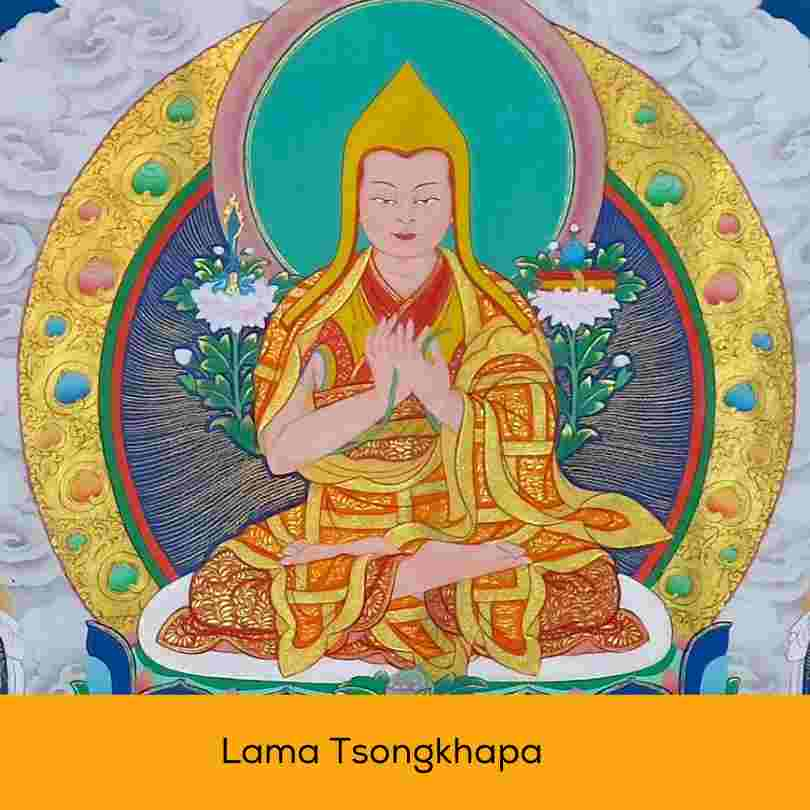Our Lineage
Our Lineage & Teachers

Lama Tsongkhapa, whose full name is Je Tsongkhapa Lobsang Drakpa, was a 14th-century Tibetan Buddhist scholar, teacher, and philosopher. He is renowned for being the founder of the Gelug school of Tibetan Buddhism, also known as the “Yellow Hat” tradition. This tradition places a strong emphasis on the systematic study of Buddhist philosophy and ethics.
Lama Tsongkhapa’s teachings are considered to be a synthesis of various Buddhist traditions, combining elements from the Kadampa, Sakya, and Kagyu schools, among others. He emphasized the importance of studying Buddhist texts, logic, and reasoning in order to gain a deep and accurate understanding of the teachings.
One of Lama Tsongkhapa’s most significant contributions is his elaboration on the concept of the Middle Way, also known as Madhyamaka, which is a philosophical approach that seeks to transcend extreme views and find a balanced understanding of reality. He also emphasized the practice of ethics, compassion, and wisdom as essential components of the path to enlightenment.
Lama Tsongkhapa’s teachings have had a profound influence on Tibetan Buddhism, particularly within the Gelug school. His work, including texts on philosophy, meditation, and practice, continues to be studied and followed by practitioners to this day. Additionally, the Gaden Tripa , who belong to the Gelug tradition, consider themselves to be his spiritual heirs and have played important roles in spreading his teachings and guiding Tibetan Buddhism.

Jetsun Sherab Sengge, born in the year 1383 in Gurme, Tsang, was the son of Dampa Marpo and Choku Tashi. From an early age, he showed little interest in welcoming visitors to his home but displayed an early curiosity about religion.
At the age of ten, he entered Nartang Monastery, where Khenchen Drubpa Sherab ordained him with the name Sherab Sengge. He received transmissions and teachings from eminent figures like Sakya scholar Yaktruk Sanggye Pel, Shangpa Kunkhyen Sherab Pelzang, and Rongton Sheja Kunrik. Full ordination followed when he turned twenty, administered by Drubpa Sherab.
In 1410, he journeyed to U and met Tsongkhapa Lobzang Drakpa, from whom he received teachings on Vinaya and Abhidharma. Subsequently, he traveled with Tsongkhapa to Won Tashi Doka, where he studied logical reasoning, Nāgārjuna’s Mūlamadhyamakakārikā, and his commentary, as well as the Essence of Eloquence on scriptural hermeneutics.
At Ganden Monastery, Tsongkhapa imparted instructions, transmissions, and commentaries on various tantric teachings, including Chakrasaṃvara, Kālachakra, and Hevajra, and Sherab Sengge diligently mastered these tantras. Later, at Sangpu Monastery, he taught Chakrasaṃvara rituals to Gendun Drub, who would become known as the First Dalai Lama.

Dulnagpa Palden Zangpo, born in 1402 in the town of Tanag Dhar of Tsang Region, Tibet had a significant spiritual journey. He was a direct disciple of Jetsun Sherab Sengge, who was the founder of Gyume, also known as the Lower Tantric College. Importantly, Jetsun Sherab Sengge himself was a direct disciple of the renowned Je Tsongkhapa.
Dulnagpa Palden Zangpo’s spiritual journey began with his ordination at Narthang Monastery. Through his devoted practice, he achieved profound spiritual realizations. He became known for his ability to heal the sick through his prayers, particularly through the recitation of Je Tsongkhapa’s Migtsema prayer, which he enjoyed teaching to others. His devotion to this practice inspired him to compose the text “Hundreds of Deities of Tushita.”
At one point in his life, a local deity named Pehar was causing distress to the people of Se in Tsang, leading to unfortunate consequences, including deaths. Dulnagpa Palden Zangpo intervened using his spiritual powers and managed to pacify Pehar, instructing the deity not to harm those who recited the Migtsema prayer he had authored.
In accordance with Je Tsongkhapa’s wishes, Jetsun Sherab Sengge traveled throughout the Tsang region of Tibet, offering teachings. In the locality of Yagshilung, he imparted his wisdom and knowledge to Dulnagpa, and in 1432, they jointly established Segyu Monastery, also known as the Tantric College of Se District. Jetsun Sherab Sengge entrusted the care of this monastery to Dulnagpa, an institution dedicated to the study and practice of tantric teachings.
He passed away in 1473 at the age of 71, leaving behind a legacy of spiritual devotion and teachings that continue to inspire practitioners in the Tibetan Buddhist tradition.
